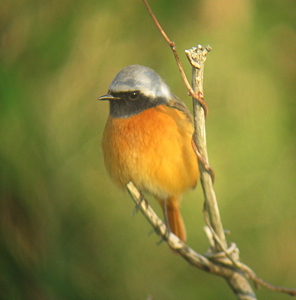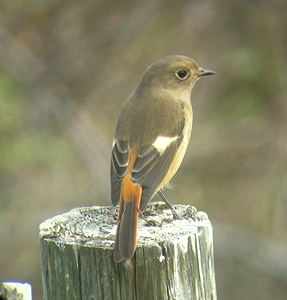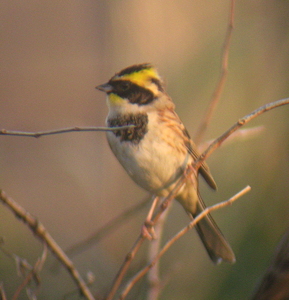Hegura-jima
Fair Isle. Cape May. Falsterbo. Eilat. Portland. Broome. These are some of the great migration watchpoints of the world.
 However, few birders, unless they live in Japan or have visited here in spring or autumn, have likely heard of Hegura, a tiny island in the Sea of Japan between the tip of the Noto Peninsula in Ishikawa Prefecture and Nakhodka and Vladivostok, on the continent.
However, few birders, unless they live in Japan or have visited here in spring or autumn, have likely heard of Hegura, a tiny island in the Sea of Japan between the tip of the Noto Peninsula in Ishikawa Prefecture and Nakhodka and Vladivostok, on the continent.
Even few Japanese appear to have heard of the remote island, 50 km north of Wajima, far removed from Tokyo or Osaka, and decidedly untropical when compared to Okinawa or the southwest islands. Its only claim to fame is its attraction to birdwatchers, fishermen and a few diehard tourists who go on a one-day return just to say they have been there.
 There used to be a thriving fishing community on Hegurajima but, as with many other places in rural Japan, the few youngsters who lived there have fled for the bright lights of the city -- or at the very least, for an easier life -- and now the ones who live there from spring through autumn are mostly elderly. The primary school has closed and is falling into disrepair, and the community centre no longer welcomes the locals like it used to. Also, as fewer and fewer people live there, several of the houses are shuttered and many look like they have seen better days.
There used to be a thriving fishing community on Hegurajima but, as with many other places in rural Japan, the few youngsters who lived there have fled for the bright lights of the city -- or at the very least, for an easier life -- and now the ones who live there from spring through autumn are mostly elderly. The primary school has closed and is falling into disrepair, and the community centre no longer welcomes the locals like it used to. Also, as fewer and fewer people live there, several of the houses are shuttered and many look like they have seen better days.
 Among Japanese birders, Hegurajima is known for its long list of rarities, and on a really good day in spring, it might be possible to see 100 species of birds -- ranging from egrets, ducks, raptors and shorebirds, to swifts and passerines of many varieties.
Among Japanese birders, Hegurajima is known for its long list of rarities, and on a really good day in spring, it might be possible to see 100 species of birds -- ranging from egrets, ducks, raptors and shorebirds, to swifts and passerines of many varieties.
The bird list for Hegura is long, but a few of the highlights -- which have included several firsts for Japan -- have been Chinese Egret, Rufous-bellied Woodpecker, Black-naped Oriole, Chestnut-winged Cuckoo, Fairy Pitta, Shorelark, White-throated Rock Thrush, Whinchat, Wood Warbler, Willow Warbler and Wilson's Warbler, Golden-crowned Sparrow, and Black Drongo. Japanese Woodpigeons are, surprisingly re gular passage migrants, and each spring a good selection of thushes, warblers and buntings pass through.
Just 1.5 km long and about 500 meters wide at the widest point, Hegura is the place to be in April/May and again in September/October when on some days migrants are pouring through on their way north or south. Because of its size, it is an easy island to cover, and migrants drop in anywhere -- in gardens, around the lighthouse, near the harbour, at the beach or by the small pond on the west coast. If conditions are right, birds can literally drop from the sky as you are walking around.
Accommodation:
There are just two places to stay, and camping is not permitted. The two minshuku are
Tsukasa (Tel: 0768- 22-8713), just east of the harbour, and Tsuki (Tel: 0768- 22-8745), on the west side of the harbour. Both are only 5 minutes or so from the ferry terminal. There are no restaurants or shops on the island, so all meals are taken where you are staying, unless you bring your own lunch for the first day or two.
Reservations are essential, and at Golden Week (in late April and early May) both places are full.
The ferry, New Hegura, sails just once a day (08:30) from Wajima port on the mainland, and arrival time on Hegura is about 10:15. It leaves Hegura at 14:30 and is back in Wajima by about 16:30. On both the outward and return journies the ferry passes close to Nanatsujima (Seven Islands), which is roughly the halfway point. Here, Streaked Shearwater and Black-tailed Gull can be seen, and Japanese Murrelet likely breeds. While crossing, keep a look out for skuas, terns and other seabirds.
In the event of rough weather the ferry is cancelled. If there is no boat, you have to stay in Wajima until the weather improves enough for it to sail. Likewise, if you are on Hegura and the weather forces the ferry to be cancelled, you will not be able to get back to Wajima until it can make the crossing. In the autumn, when typhoons pass over the Japanese archipelago, it can sometimes be two or three days before the boat comes across.
For information about ferry sailings to and from Hegura check out the ferry website or call the ferry office (Tel: 0768-22-4381).
For accommodation in Wajima, Suzuki-san at Minshuku Hakutoen (Tel: 0768-22-2178) is very welcoming, and you will be given a huge dinner and breakfast with many of the local seafood specialities served.
Another possibility is the Route Inn Wajima business hotel (Tel: 0768-22-7700)
As Wajima is a popular tourist destination -- known for its morning market and lacquerware -- there are many other places to stay, including some rather nice, but more expensive, ryokan with hot spring baths. There is a tourist information centre at the old station, which is now the bus terminal for the express buses to Kanazawa, the prefectural capital about two hours away.
Also nearby is the new(ish) Noto Airport, with two flights per day on ANA to Tokyo Haneda. A local taxi service (Minato Kanko Bus 港観光バス Tel: 0768-22-7411) will take you from the airport to Wajima, just a few kilometres distant. Reservations are recommended. It will cost 900 yen per person into Wajima.
The ANA flight schedule is:
Haneda 09:55 departure 発 Noto 10:55 arrival 着
Haneda 14:30 departure 発 Noto 15:30 arrival 着
Noto 11:35 departure 発 Haneda 12:40 arrival 着
Noto 16:05 departure発 Haneda17:10 arrival着
© 2012 Mark Brazil & Chris Cook
Last updated: 20120825
